Satas D., Tracton A.A. (ed.). Coatings Technology Handbook
Подождите немного. Документ загружается.

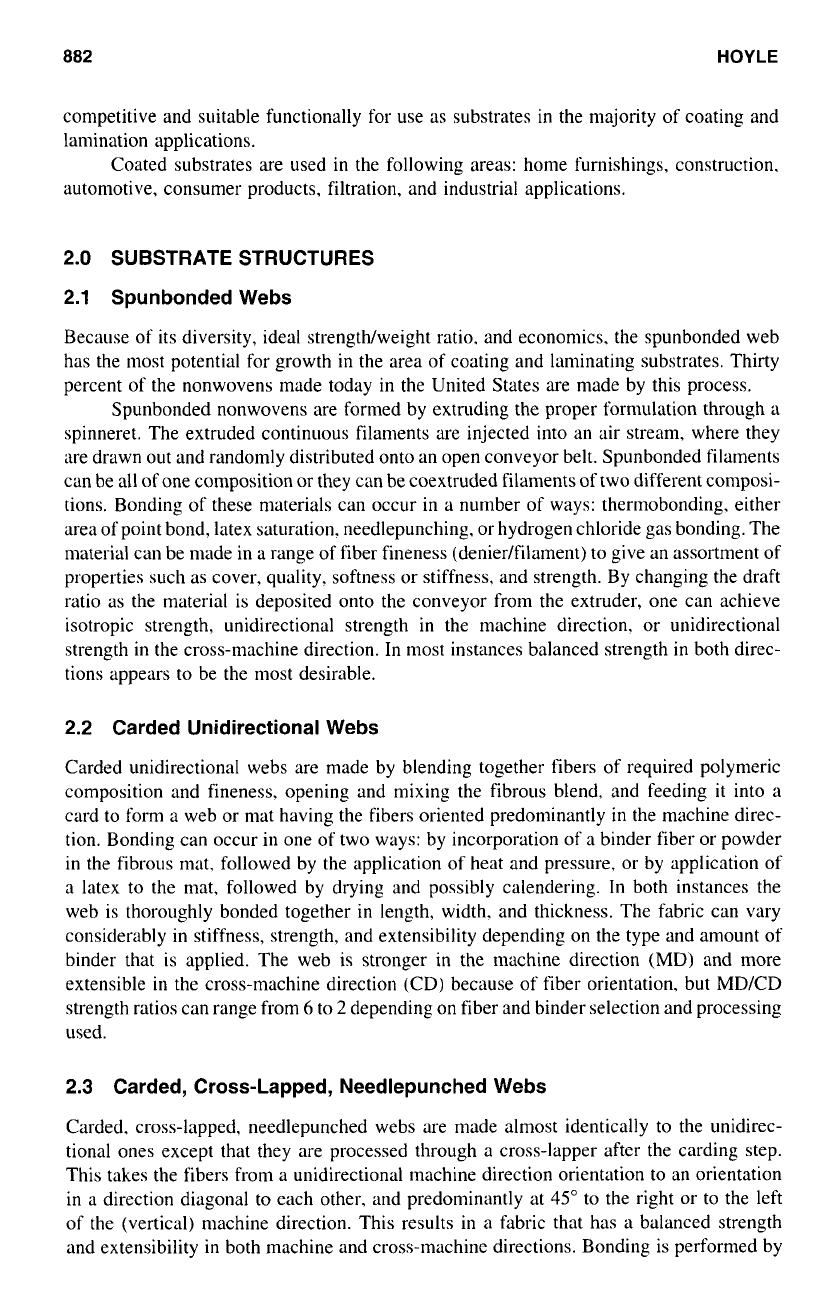
882
HOYLE
competitive and suitable functionally for use as substrates
in
the majority of coating and
lamination applications.
Coated substrates are used
in
the following areas: home furnishings, construction.
automotive, consumer products, filtration, and industrial applications.
2.0
SUBSTRATE STRUCTURES
2.1
Spunbonded Webs
Because of its diversity, ideal strengtwweight ratio. and economics, the spunbonded web
has the most potential for growth in the area of coating and laminating substrates. Thirty
percent of the nonwovens made today in the United States are made by this process.
Spunbonded nonwovens are formed by extruding the proper formulation through
a
spinneret. The extruded continuous filaments are injected into an air stream, where they
are drawn out and randomly distributed
onto
an open conveyor belt. Spunbonded filaments
can be all of one composition or they can be coextruded filaments of two different composi-
tions. Bonding of these materials can occur in a number of ways: thermobonding. either
area of point bond, latex saturation. needlepunching, or hydrogen chloride gas bonding. The
material can be made in a range
of
fiber fineness (deniedfilament) to give an assortment of
properties such as cover, quality. softness or stiffness, and strength. By changing the draft
ratio as the material is deposited onto the conveyor from the extruder, one can achieve
isotropic strength, unidirectional strength
in
the machine direction. or unidirectional
strength in the cross-machine direction. In most instances balanced strength in both direc-
tions appears
to
be the most desirable.
2.2
Carded Unidirectional Webs
Carded unidirectional webs are made by blending together tibers of required polymeric
composition and fineness, opening and mixing the fibrous blend, and feeding
it
into a
card to form a web or mat having the fibers oriented predominantly
in
the machine direc-
tion. Bonding can occur in one of two ways: by incorporation of a binder fiber or powder
in
the fibrous mat, followed by the application of heat and pressure, or by application of
a latex
to
the mat, followed by drying and possibly calendering. In both instances the
web is thoroughly bonded together in length, width. and thickness. The fabric can vary
considerably in stiffness, strength, and extensibility depending on the type and amount of
binder that is applied. The web is stronger in the machine direction (MD) and more
extensible
in
the cross-machine direction
(CD)
because of fiber orientation, but MD/CD
strength ratios can range from
6
to
2
depending on fiber and binder selection and processing
used.
2.3
Carded, Cross-Lapped, Needlepunched Webs
Carded. cross-lapped. needlepunched webs are made almost identically to the unidirec-
tional ones except that they are processed through a cross-lapper after the carding step.
This takes the fibers from a unidirectional machine direction orientation to an orientation
in a direction diagonal
to
each other, and predonlinantly at
45"
to the right or to the left
of the (vertical) machine direction. This results in
a
fabric that has a balanced strength
and extensibility
in
both machine and cross-machine directions. Bonding is performed by
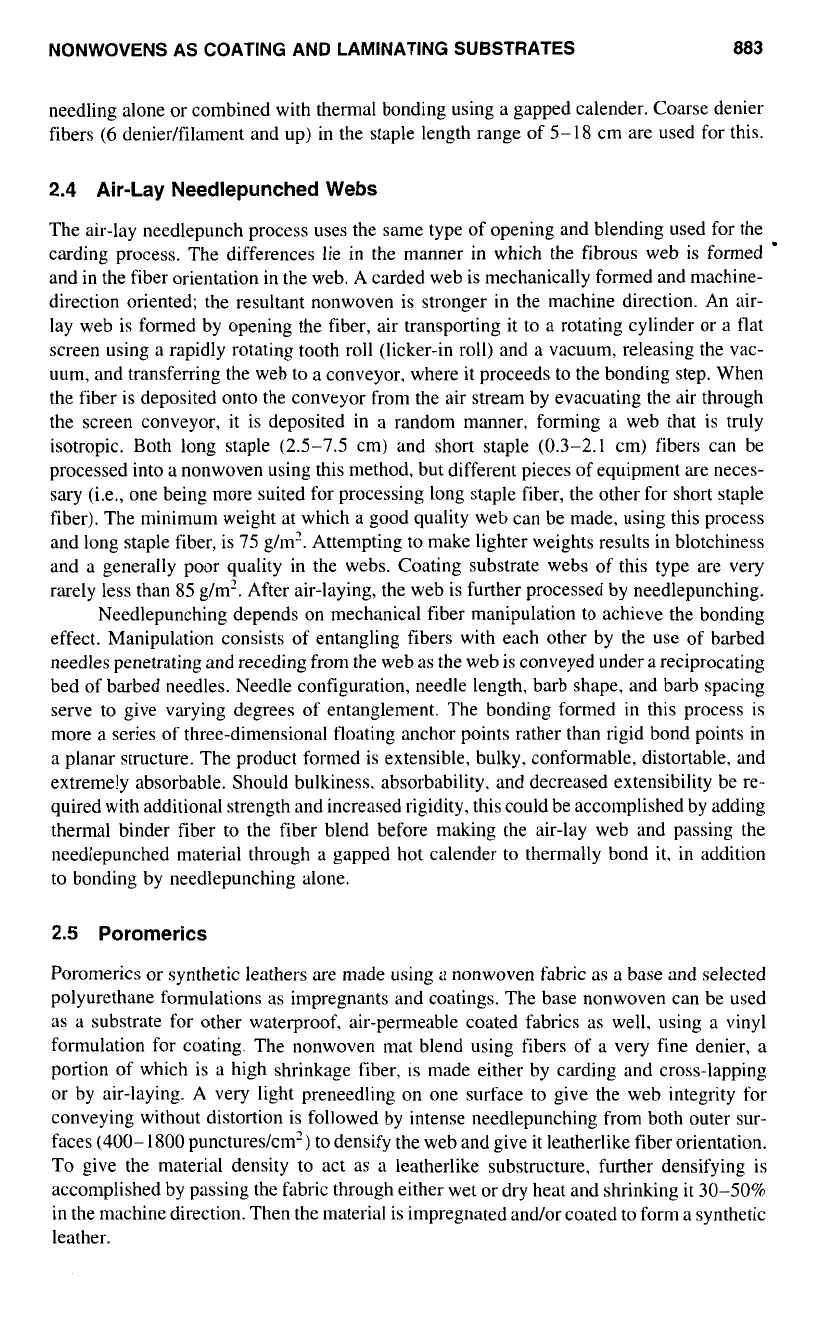
NONWOVENS AS COATING AND LAMINATING SUBSTRATES
883
needling alone or combined with thermal bonding using a gapped calender. Coarse denier
fibers
(6
deniedfilament and up) in the staple length range of 5-18 cm are used for this.
2.4
Air-Lay
Needlepunched Webs
The air-lay needlepunch process uses the same type of opening and blending used for the
carding process. The differences lie
in
the manner in which the fibrous web is formed
and in the fiber orientation in the web. A carded web is mechanically formed and machine-
direction oriented; the resultant nonwoven is stronger in the machine direction. An air-
lay web is formed by opening the fiber, air transporting it to a rotating cylinder or a flat
screen using a rapidly rotating tooth roll (licker-in roll) and a vacuum, releasing the vac-
uum, and transferring the web to a conveyor, where it proceeds to the bonding step. When
the fiber is deposited onto the conveyor from the air stream by evacuating the air through
the screen conveyor, it is deposited in a random manner, forming a web that is truly
isotropic. Both long staple (2.5-7.5 cm) and short staple (0.3-2.1 cm) fibers can be
processed into a nonwoven using this method, but different pieces of equipment are neces-
sary (i.e., one being more suited for processing long staple fiber, the other for short staple
fiber). The minimum weight at which a good quality web can be made, using this process
and long staple fiber, is
75
g/m’. Attempting to make lighter weights results in blotchiness
and a generally poor quality in the webs. Coating substrate webs
of
this type are very
rarely less than 85 g/m’. After air-laying, the web is further processed by needlepunching.
Needlepunching depends on mechanical fiber manipulation to achieve the bonding
effect. Manipulation consists
of
entangling fibers with each other by the use of barbed
needles penetrating and receding from the web as the web is conveyed under a reciprocating
bed of barbed needles. Needle configuration, needle length, barb shape, and barb spacing
serve to give varying degrees
of
entanglement. The bonding formed in this process is
more a series of three-dimensional tloating anchor points rather than rigid bond points in
a planar structure. The product formed is extensible, bulky, conformable, distortable, and
extremely absorbable. Should bulkiness. absorbability, and decreased extensibility be re-
quired with additional strength and increased rigidity, this could be accomplished by adding
thermal binder fiber to the fiber blend before making the air-lay web and passing the
needlepunched material through a gapped hot calender to thermally bond it. in addition
to bonding by needlepunching alone.
2.5
Poromerics
Poromerics or synthetic leathers are made using
a
nonwoven fabric as a base and selected
polyurethane fonnulations as impregnants and coatings. The base nonwoven can be used
as a substrate for other waterproof, air-permeable coated fabrics as well. using a vinyl
formulation for coating. The nonwoven mat blend using fibers of a very fine denier, a
portion of which is a high shrinkage fiber. is made either by carding and cross-lapping
or by air-laying. A very light preneedling on one surface
to
give the web integrity for
conveying without distortion is followed by intense needlepunching from both outer sur-
faces (400- 1800 punctureslcm’) to densify the web and give it leatherlike fiber orientation.
To
give the material density to act as a leatherlike substructure, further densifying is
accomplished by passing the fabric through either wet or dry heat and shrinking it 30-50%
in the machine direction. Then the material is impregnated and/or coated
to
form a synthetic
leather.
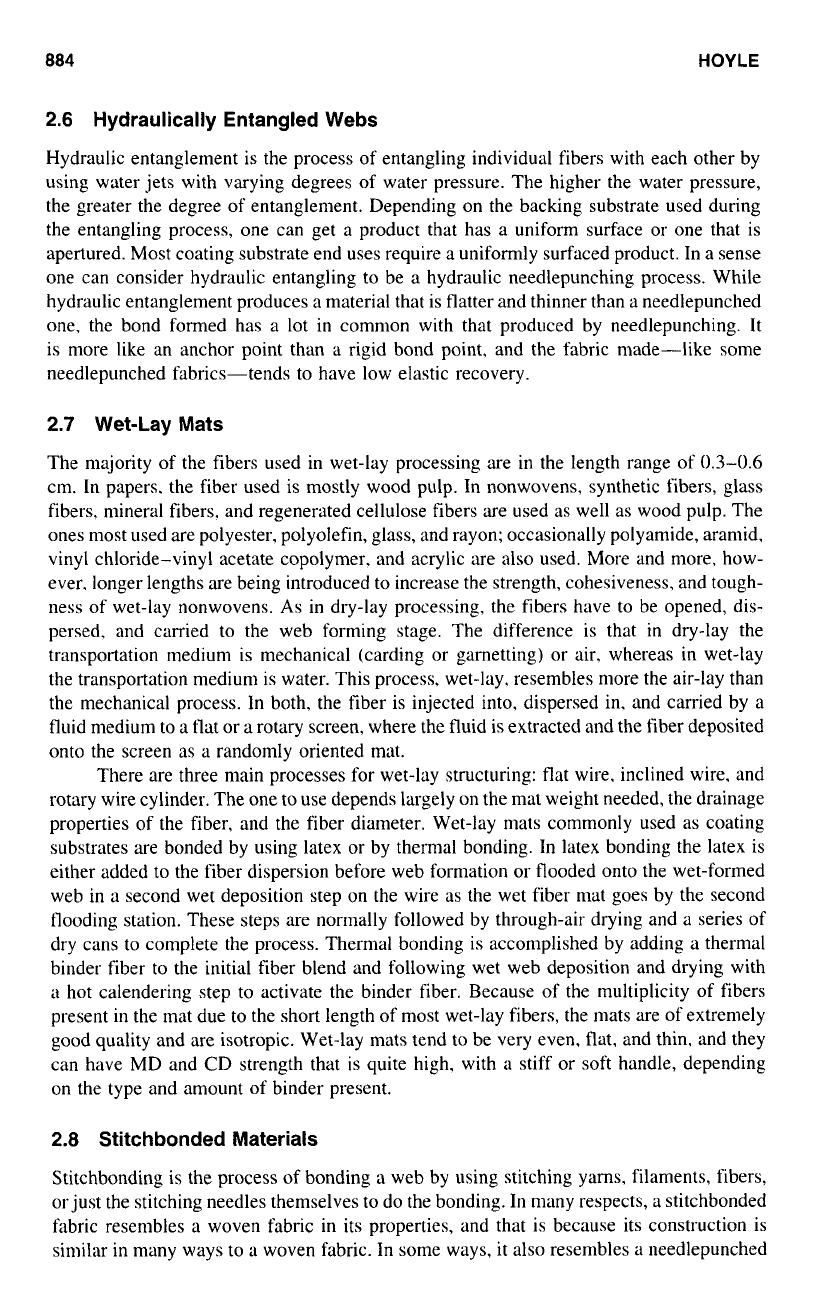
884
HOYLE
2.6 Hydraulically Entangled Webs
Hydraulic entanglement is the process of entangling individual fibers with each other by
using water jets with varying degrees
of
water pressure. The higher the water pressure,
the greater the degree of entanglement. Depending
on
the backing substrate used during
the entangling process, one can get a product that has a uniform surface
or
one that is
apertured. Most coating substrate end uses require
a
uniformly surfaced product. In a sense
one can consider hydraulic entangling to be
a
hydraulic needlepunching process. While
hydraulic entanglement produces
a
material that is flatter and thinner than a needlepunched
one, the bond formed has a lot in common with that produced by needlepunching.
It
is more like an anchor point than a rigid bond point, and the fabric made-like some
needlepunched fabrics-tends to have low elastic recovery.
2.7
Wet-Lay Mats
The majority
of
the fibers used in wet-lay processing are in the length range of
0.3-0.6
cm. In papers. the fiber used is mostly wood pulp. In nonwovens, synthetic fibers, glass
fibers, mineral fibers. and regenerated cellulose fibers are used as well
as
wood pulp. The
ones most used are polyester, polyolefin, glass, and rayon; occasionally polyamide, aramid.
vinyl chloride-vinyl acetate copolymer. and acrylic are also used. More and more, how-
ever. longer lengths are being introduced
to
increase the strength, cohesiveness, and tough-
ness of wet-lay nonwovens.
As
in dry-lay processing, the fibers have to be opened, dis-
persed, and carried to the web forming stage. The difference is that
in
dry-lay the
transportation medium is mechanical (carding or garnetting) or air, whereas in wet-lay
the transportation medium is water. This process, wet-lay, resembles more the air-lay than
the mechanical process. In both, the fiber is injected into, dispersed in. and carried by a
fluid medium to a flat or a rotary screen, where the fluid is extracted and the fiber deposited
onto the screen as a randomly oriented mat.
There are three main processes for wet-lay structuring: flat wire. inclined wire. and
rotary wire cylinder. The one
to
use depends largely on the mat weight needed, the drainage
properties of the fiber, and the fiber diameter. Wet-lay mats commonly used as coating
substrates are bonded by using latex
or
by thermal bonding. In latex bonding the latex is
either added to the fiber dispersion before web formation or flooded onto the wet-formed
web in
a
second wet deposition step on the wire as the wet fiber mat goes by the second
flooding station. These steps are normally followed by through-air drying and a series of
dry cans to complete the process. Thermal bonding is accomplished by adding a thermal
binder fiber to the initial fiber blend and following wet web deposition and drying with
a
hot calendering step to activate the binder fiber. Because of the multiplicity of fibers
present in the mat due
to
the short length
of
most wet-lay fibers, the mats are of extremely
good quality and are isotropic. Wet-lay mats tend to be very even, flat. and thin, and they
can have
MD
and
CD
strength that
is
quite high. with
a
stiff
or
soft handle, depending
on the type and amount of binder present.
2.8
Stitchbonded Materials
Stitchbonding is the process
of
bonding a web by using stitching yarns, filaments, fibers,
or just the stitching needles themselves
to
do the bonding. In many respects, a stitchbonded
fabric resembles a woven fabric in its properties, and that is because its construction is
similar in many ways to a woven fabric. In some ways, it also resembles a needlepunched

NONWOVENS AS COATING AND LAMINATING SUBSTRATES
a85
or hydraulically entangled fabric, especially in the lighter stitching constructions and when
no yarn
or
thread is used
in
stitchbonding.
3.0
END-USE APPLICATIONS
3.1
Home Furnishings
3.1.1 Tablecloths
The nonwoven substrate for tablecloths could be a spunbond, a needled material. or a
hydraulically entangled one. The substrate would be coated with a nonblocking vinyl
formulation, dried, then color printed and/or embossed for aesthetic reasons. Properties
needed in the substrate are softness. flexibility, isotropic strength, and puncture or snag
resistance. The substrate could be a polyamide spunbonded with an acrylic latex binder,
a needled polyester-rayon blend, or a hydraulically entangled polyester in the 45-55 g/
m’ range.
3.1.2 Upholstery
A typical nonwoven substrate for vinyl upholstery would have the following specifications:
weight,
140
glm’; composition,
100%
polyester fiber; process, needlepunching an air-lay
or
a
carded cross-lapped material; tensile strength, 35-45 Ib/in. MD and CD; and extensi-
bility, MD
loo%,
CD
50%.
Depending on end-use requirements, the substrate could also
be composed of polypropylene, and it could be made using hydraulic entanglement or
spunbonding as the bonding process.
3.1.3
Draperies
A suitable drapery composition would be a stitchbonded fabric coated with a pigmented
opaque acrylic foam as an inner liner. Also acceptable would be a hydraulically entangled
polyester used as a liner and reinforcement for a woven fabric (i.e., a flame-retardant
drape made using a woven fiberglass fabric and a hydrolically entangled vinyl chloride
base fiber web as a liner.
3.2
Construction Uses
3.2.1 Vinyl
Floor
Tile Reinforeenrent
A
spunbonded, heat-bonded, copolyester fabric, weighing
50
g/m’, with an MD and CD
tensile strength of 35-40 lb/in., and an extensibility of
15%,
MD and CD, is suitable as
a floor tile base.
3.2.2 Roofing
Menlbrcrne
Substrate
A spunbonded polyester using an acrylic binder for heat resistance, instead of a copolymer
thermal binder fiber system. in a weight range
25-100
g/m’, is recommended as a roofing
membrane substrate.
3.3
Automotive: Landau
Tops,
Interior Paneling, and Car Seats
A
needlepunched,
100%
polyester nonwoven laminated to a polyurethane foam on the
bottom surface can be used as a coating base for a vinyl-coated fabric that is to be color
printed and/or embossed. Substrates for tops are usually heavier, stronger, and less extensi-
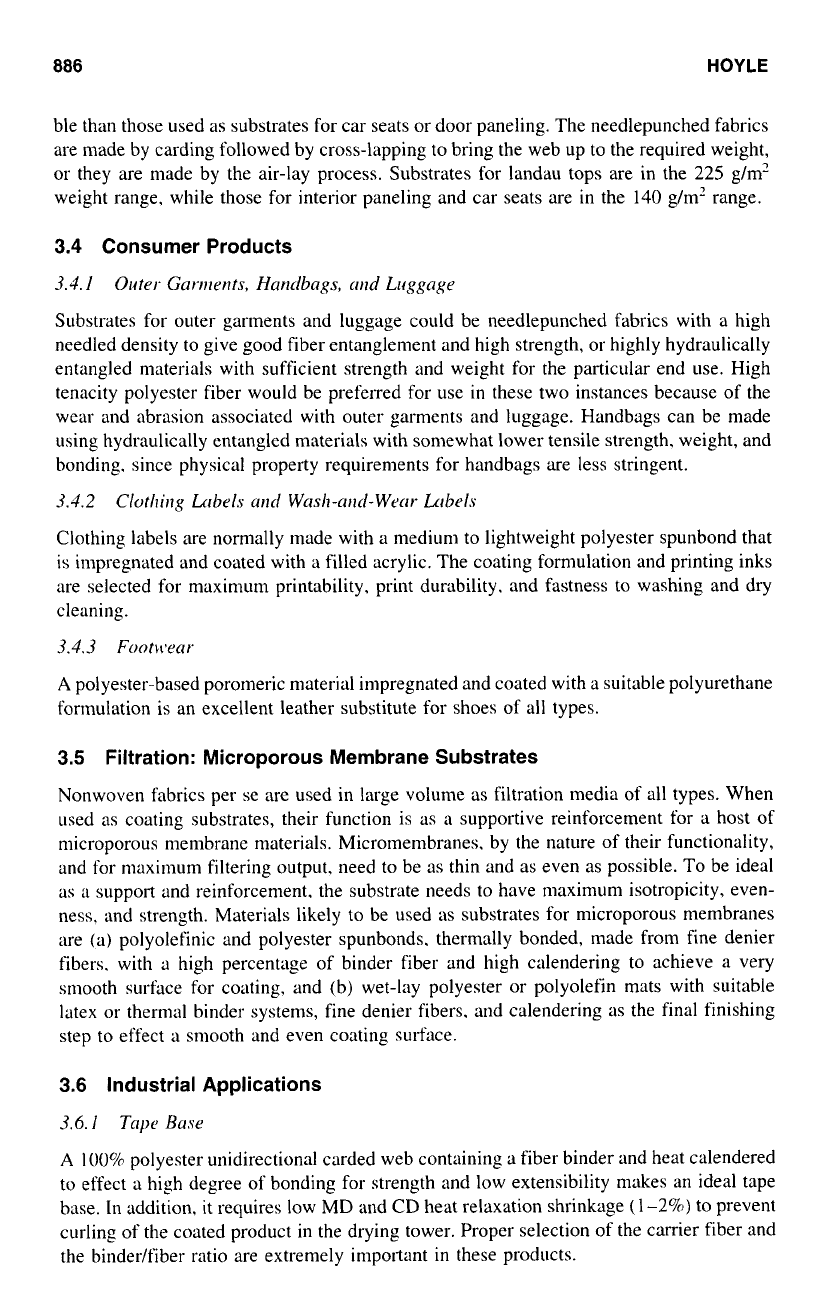
886
HOYLE
ble than those used as substrates for car seats or door paneling. The needlepunched fabrics
are made by carding followed by cross-lapping to bring the web up to the required weight,
or they are made by the air-lay process. Substrates for landau tops are in the
225
g/m’
weight range, while those for interior paneling and car seats are in the
140
g/m’ range.
3.4
Consumer Products
3.4.
I
Outer. Garments, Handbags,
md
Luggage
Substrates for outer garments and luggage could be needlepunched fabrics with a high
needled density to give good fiber entanglement and high strength,
or
highly hydraulically
entangled materials with sufficient strength and weight for the particular end use. High
tenacity polyester fiber would be preferred for use
in
these two instances because of the
wear and abrasion associated with outer garments and luggage. Handbags can be made
using hydraulically entangled materials with somewhat lower tensile strength. weight, and
bonding. since physical property requirements for handbags are less stringent.
3.3.2
Clothirlg
L41bel.s
(111d
W~~~h-~~~~l-W~~~~
Libels
Clothing labels are normally made with a medium to lightweight polyester spunbond that
is impregnated and coated with a filled acrylic. The coating formulation and printing inks
are selected for maximum printability, print durability. and fastness to washing and dry
cleaning.
3.4.3
Footnvar
A
polyester-based poromeric material impregnated and coated with a suitable polyurethane
formulation is an excellent leather substitute for shoes of all types.
3.5
Filtration: Microporous Membrane Substrates
Nonwoven fabrics per se are used in large volume as filtration media of all types. When
used as coating substrates, their function is as
a
supportive reinforcement for a host
of
microporous membrane materials. Micromembranes. by the nature of their functionality,
and for maximum filtering output. need to be as thin and as even as possible. To be ideal
as
a
support and reinforcement. the substrate needs to have maximum isotropicity, even-
ness, and strength. Materials likely to be used
as
substrates for microporous membranes
are (a) polyolefinic and polyester spunbonds. thermally bonded, made from fine denier
fibers. with a high percentage of binder fiber and high calendering to achieve a very
smooth surface for coating. and (b) wet-lay polyester or polyolefin mats with suitable
latex or thermal binder systems, fine denier fibers. and calendering as the final finishing
step to effect
a
smooth and even coating surface.
3.6
Industrial Applications
3.6.1
Tape Base
A
100%
polyester unidirectional carded web containing a fiber binder and heat calendered
to effect a high degree
of
bonding for strength and low extensibility makes an ideal tape
base. In addition. it requires low
MD
and CD heat relaxation shrinkage
(1
-2%)
to prevent
curling of the coated product in the drying tower. Proper selection
of
the carrier fiber and
the binder/fiber ratio are extremely important
in
these products.
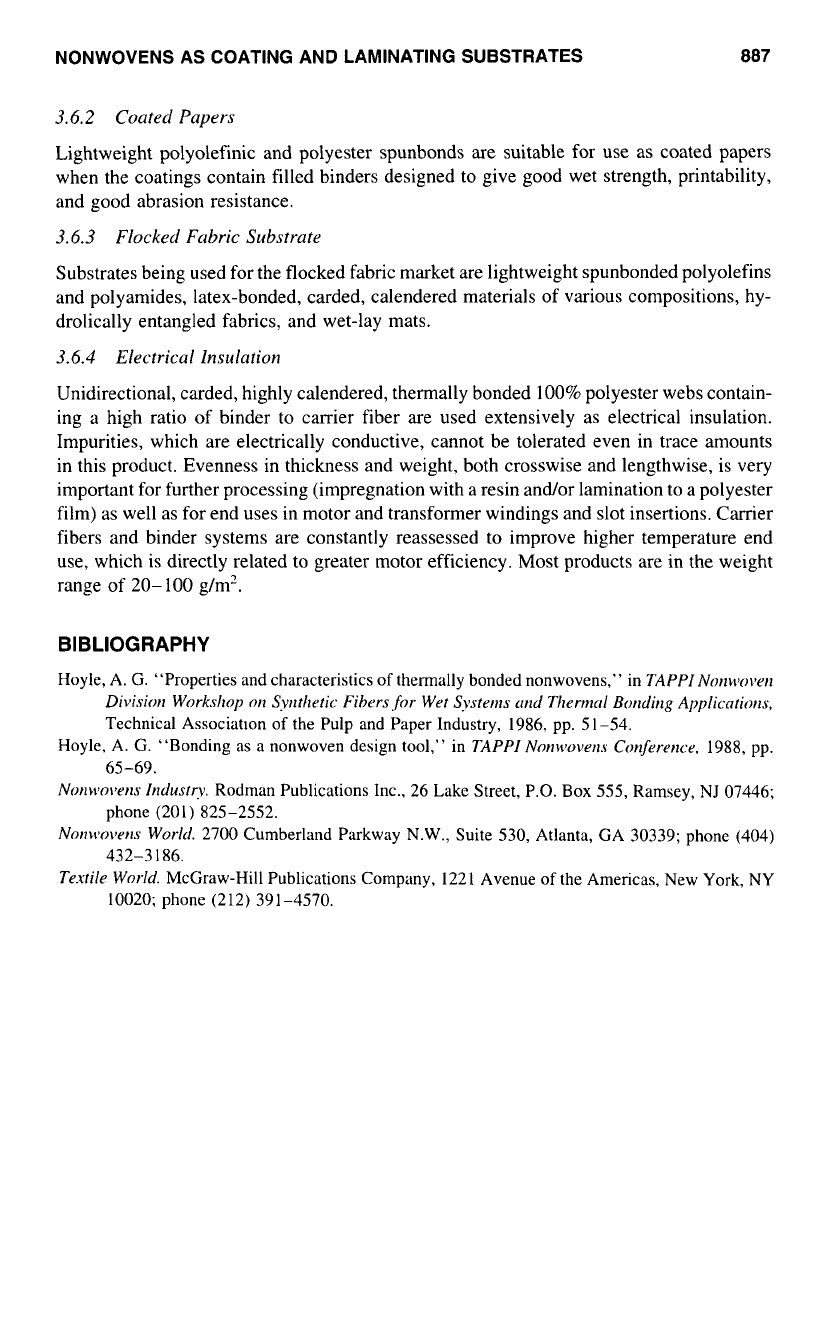
NONWOVENS AS COATING AND LAMINATING SUBSTRATES
3.6.2 Coated Papers
Lightweight polyolefinic and polyester spunbonds are suitable for use as coated papers
when the coatings contain filled binders designed to give good wet strength, printability,
and good abrasion resistance.
3.6.3 Flocked Fubric Substrate
Substrates being used for the flocked fabric market are lightweight spunbonded polyolefins
and polyamides, latex-bonded, carded, calendered materials of various compositions, hy-
drolically entangled fabrics, and wet-lay mats.
3.6.4
Electrical Insulation
Unidirectional, carded, highly calendered, thermally bonded
100%
polyester webs contain-
ing a high ratio of binder
to
carrier fiber are used extensively as electrical insulation.
Impurities, which are electrically conductive, cannot be tolerated even in trace amounts
in this product. Evenness in thickness and weight, both crosswise and lengthwise, is very
important for further processing (impregnation with a resin andor lamination to a polyester
film)
as
well as for end uses in motor and transformer windings and slot insertions. Carrier
fibers and binder systems are constantly reassessed
to
improve higher temperature end
use, which is directly related to greater motor efficiency. Most products are in the weight
range of 20-100 g/m’.
BIBLIOGRAPHY
Hoyle, A. G. “Properties and characteristics
of
thermally bonded nonwovens,” in
TAPPI
Nor~w~over~
Divisiorl
Workshop
on
Svrltlwtic
Fibers
.for Wet
Swterns
LIII~
Thertncrl
Boruiirlg
Applicntiorls,
Technical Association
of
the Pulp and Paper Industry, 1986, pp. 51-54.
Hoyle,
A.
G. “Bonding
as
a
nonwoven design tool,” in
TAPPI
Nonwovrru
Conference.
1988, pp.
Nonnwert.s
1tzdustt-y.
Rodman Publications Inc., 26 Lake Street,
P.O.
Box
555, Ramsey,
NJ
07446;
Nonnwveru
World.
2700 Cumberland Parkway N.W., Suite 530, Atlanta, CA 30339; phone (404)
Textile
World.
McGraw-Hill Publications Company, 1221 Avenue
of
the Americas, New York, NY
65-69.
phone (201) 825-2552.
432-3 186.
10020; phone (212) 391-4570.
This Page Intentionally Left Blank
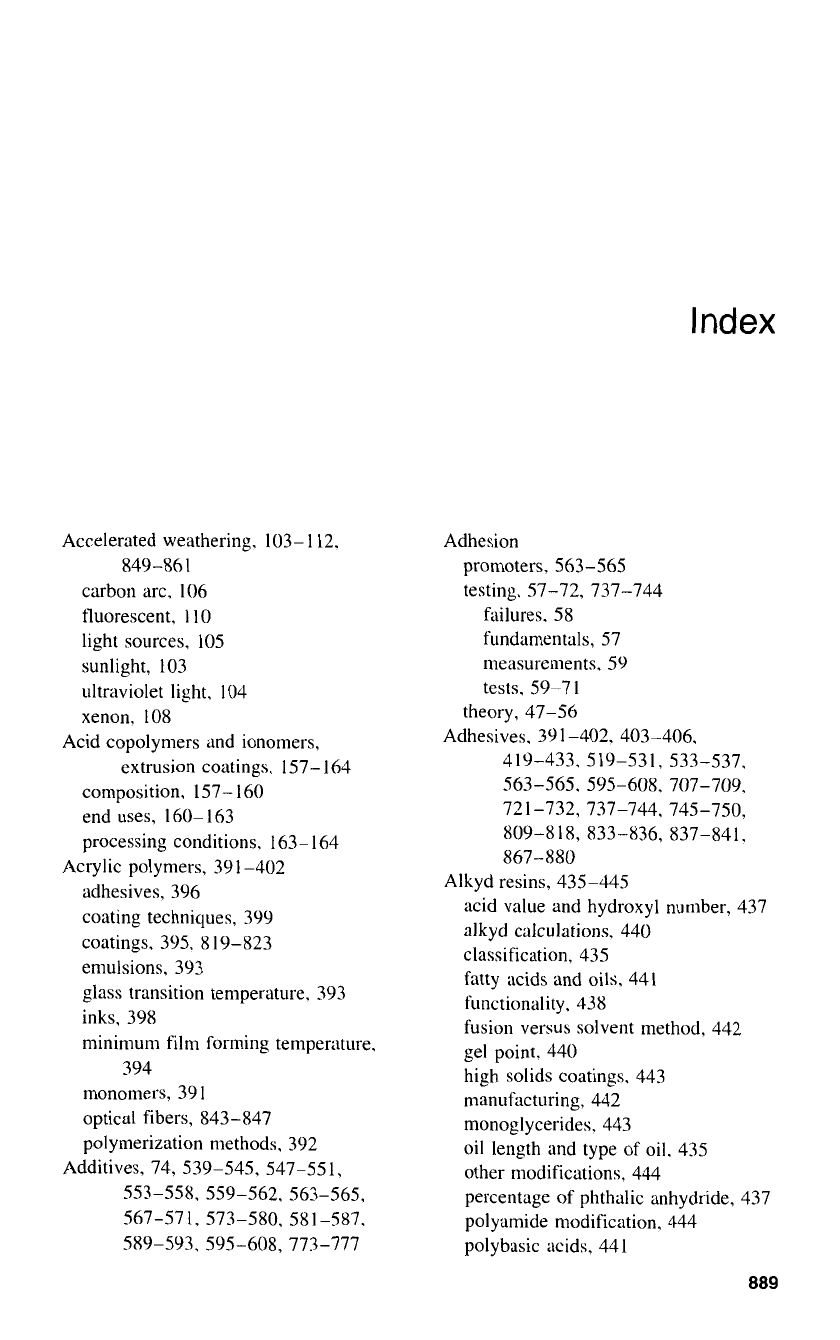
Index
Accelerated weathering.
103-
1
12.
849-861
carbon arc,
106
fluorescent,
1
10
light sources,
105
sunlight, 103
ultraviolet light, 104
xenon. 108
Acid copolymers and ionomers,
extrusion coatings. 157- 164
composition, 157-160
end uses,
160-
163
processing conditions.
163-
164
Acrylic polymers, 391 -402
adhesives, 396
coating techniques,
399
coatings, 395. 8 19-823
emulsions, 393
glass transition temperature.
393
inks, 398
minimum film forming temperature,
394
monomers, 39
1
optical fibers, 843-847
polymerization methods, 392
Additives, 74, 539-545. 547-55
1,
553-558,
559-562.
563-565.
567-57
1,
573-580,
581
-587.
589-593, 595-608.773-777
Adhesion
promoters,
563-565
testing, 57-72, 737-744
failures. 58
fundamentals, 57
measurements. 59
tests. 59-7
1
theory, 47-56
Adhesives. 39
1
-402. 403-406.
419-433. 519-531, 533-537.
563-565.
595-608. 707-709.
72 1-732, 737-744. 745-750.
809-8
18,
833-836,
837-841.
867-880
Alkyd resins, 435-445
acid value and hydroxyl number, 437
alkyd calculations, 440
classification, 435
fatty acids and oils, 441
functionality, 438
fusion versus solvent method, 442
gel point. 440
high solids coatings, 443
manufacturing, 442
monoglycerides, 443
oil length and type
of
oil. 435
other modifications, 444
percentage of phthalic anhydride, 437
polyamide modification, 444
polybasic acids, 441
889
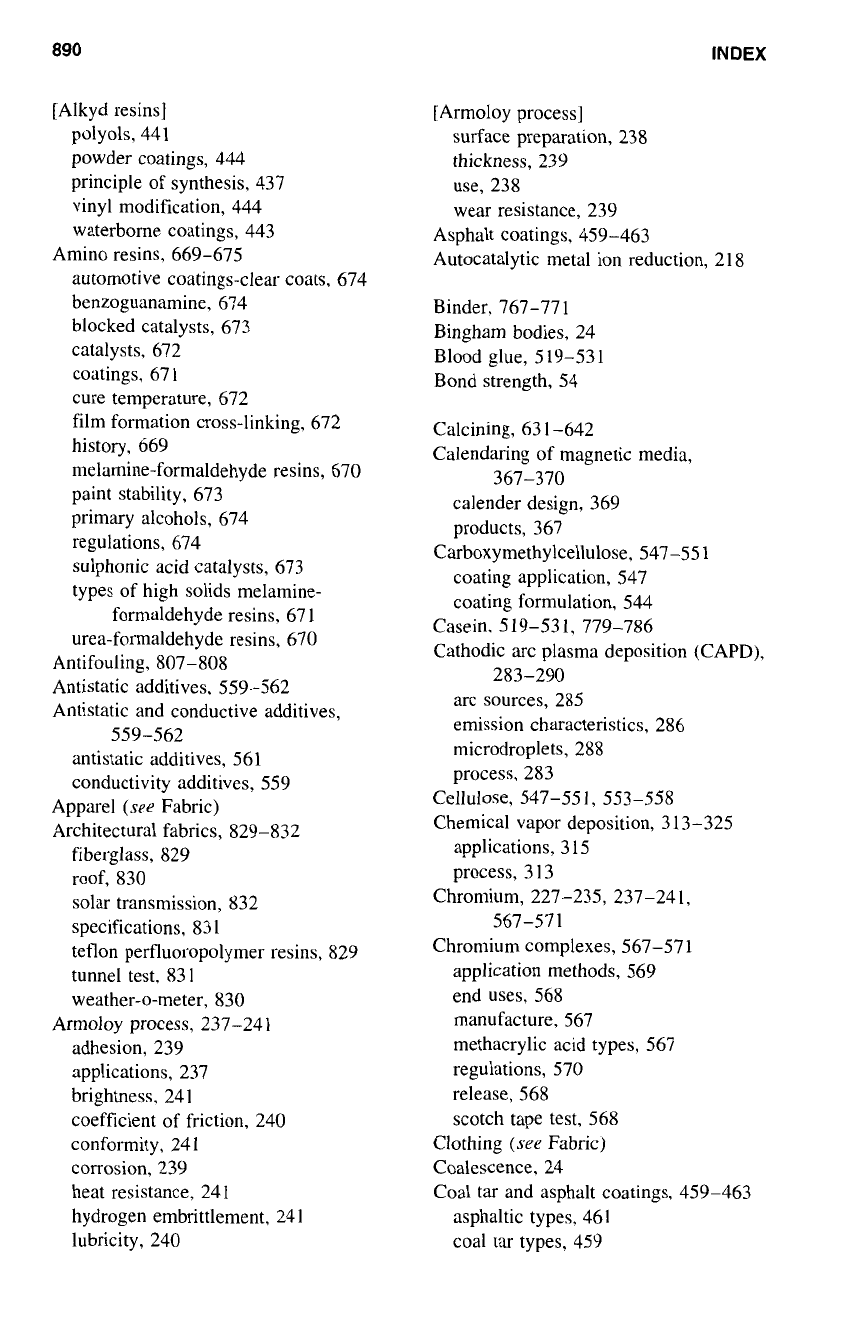
890
INDEX
[AIkyd resins]
polyols. 441
powder coatings, 444
principle of synthesis, 437
vinyl modification, 444
waterborne coatings, 443
Amino resins, 669-675
automotive coatings-clear coats, 674
benzoguanamine, 674
blocked catalysts, 673
catalysts, 672
coatings, 67
1
cure temperature, 672
film formation cross-linking, 672
history, 669
melamine-formaldehyde resins, 670
paint stability, 673
primary alcohols, 674
regulations, 674
sulphonic acid catalysts, 673
types of high solids melamine-
formaldehyde resins, 67 1
urea-formaldehyde resins, 670
Antifouling, 807-808
Antistatic additives, 559-562
Antistatic and conductive additives,
559-562
antistatic additives, 561
conductivity additives, 559
Apparel
(see
Fabric)
Architectural fabrics, 829-832
fiberglass, 829
roof, 830
solar transmission, 832
specifications, 83
1
teflon perfluoropolymer resins, 829
tunnel test,
831
weather-o-meter, 830
Armoloy process, 237-24
I
adhesion, 239
applications, 237
brightness. 241
coefficient of friction, 240
conformity, 241
corrosion, 239
heat resistance, 241
hydrogen embrittlement, 24
1
lubricity, 240
[Armoloy process]
surface preparation, 238
thickness, 239
use, 238
wear resistance, 239
Asphalt coatings, 459-463
Autocatalytic metal ion reduction, 2 18
Binder, 767-771
Bingham bodies, 24
Blood glue, 519-531
Bond strength, 54
Calcining, 63 1-642
Calendaring
of
magnetic media,
367-370
calender design, 369
products, 367
coating application, 547
coating formulation, 544
Casein. 519-53
1,
779-786
Cathodic arc plasma deposition (CAPD),
Carboxymethylcellulose, 547-55 1
283-290
arc sources, 285
emission characteristics, 286
microdroplets, 288
process, 283
Cellulose, 547-55
I,
553-558
Chemical vapor deposition, 3 13-325
applications, 3 15
process, 3 13
Chromium, 227-235, 237-241,
Chromium complexes, 567-57 1
567-571
application methods, 569
end uses, 568
manufacture, 567
methacrylic acid types, 567
regulations, 570
release, 568
scotch tape test, 568
Clothing
(see
Fabric)
Coalescence, 24
Coal tar and asphalt coatings, 459-463
asphaltic types, 461
coal tar types, 459
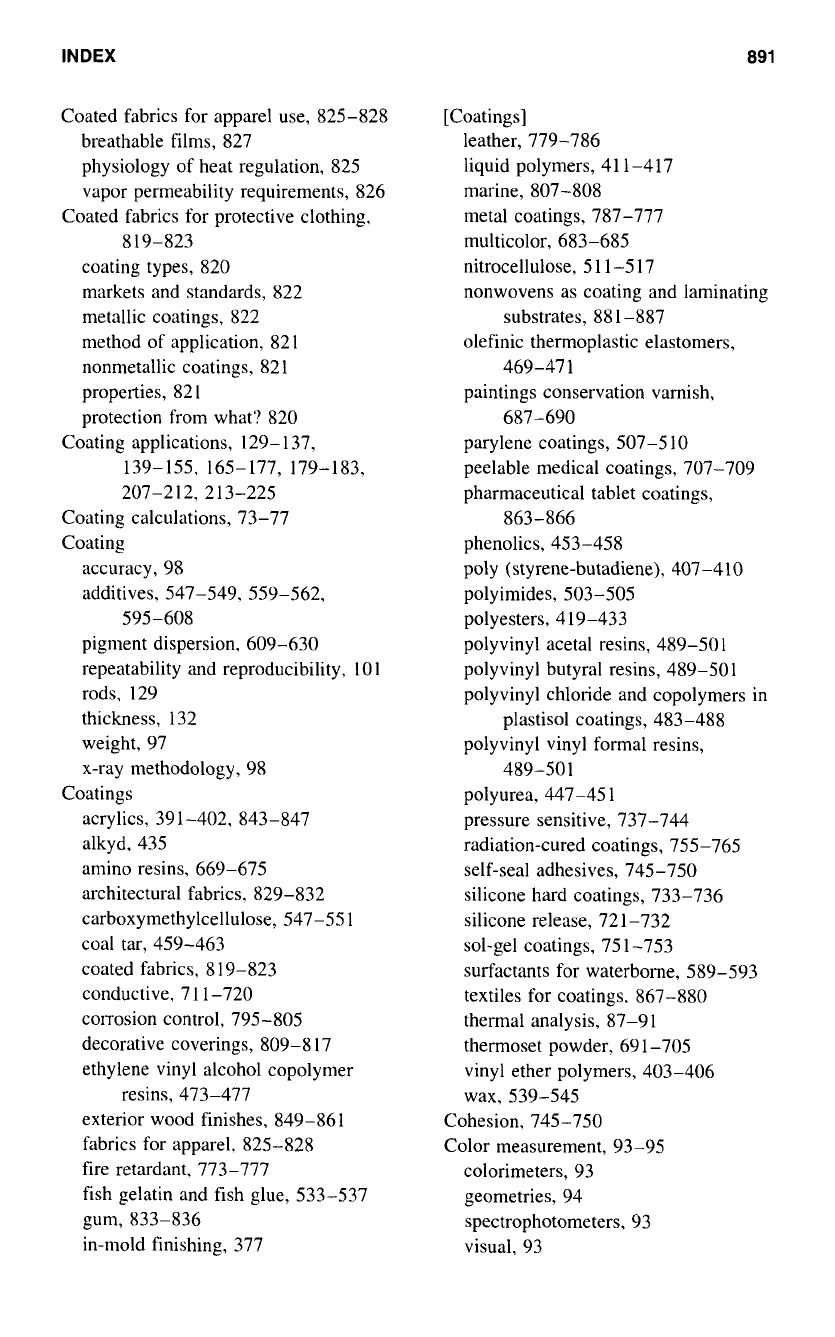
INDEX
891
Coated fabrics for apparel use, 825-828
breathable films, 827
physiology of heat regulation, 825
vapor permeability requirements, 826
Coated fabrics for protective clothing,
819-823
coating types, 820
markets and standards, 822
metallic coatings, 822
method of application, 82
1
nonmetallic coatings, 82
1
properties, 82
I
protection from what'? 820
Coating applications, 129- 137,
139-155, 165-177, 179-183,
207-2 12, 2 13-225
Coating calculations, 73-77
Coating
accuracy, 98
additives, 547-549, 559-562,
595-608
pigment dispersion, 609-630
repeatability and reproducibility, 10
1
rods, 129
thickness, 132
weight, 97
x-ray methodology, 98
acrylics, 39 1-402. 843-847
alkyd. 435
amino resins, 669-675
architectural fabrics. 829-832
carboxyn~ethylcellulose,
547-55
1
coal tar, 459-463
coated fabrics, 819-823
conductive, 7
I
1-720
corrosion control, 795-805
decorative coverings, 809-8 17
ethylene vinyl alcohol copolymer
exterior wood finishes, 849-861
fabrics for apparel, 825-828
fire retardant, 773-777
fish gelatin and
fish
glue, 533-537
gum, 833-836
in-mold finishing, 377
Coatings
resins, 473-477
[Coatings]
leather, 779-786
liquid polymers, 4
1
1-41 7
marine, 807-808
metal coatings, 787-777
multicolor, 683-685
nitrocellulose,
5
1
1-5
17
nonwovens
as
coating and laminating
olefinic thermoplastic elastomers,
paintings conservation varnish,
parylene coatings, 507-5
10
peelable medical coatings, 707-709
pharmaceutical tablet coatings,
863-866
phenolics, 453-458
poly (styrene-butadiene), 407-410
polyimides, 503-505
polyesters, 419-433
polyvinyl acetal resins, 489-501
polyvinyl butyral resins, 489-50
1
polyvinyl chloride and copolymers
in
plastisol coatings, 483-488
polyvinyl
vinyl
formal resins,
polyurea. 447-45
1
pressure sensitive, 737-744
radiation-cured coatings, 755-765
self-seal adhesives, 745-750
silicone hard coatings, 733-736
silicone release, 721-732
sol-gel coatings, 75 1-753
surfactants for waterborne, 589-593
textiles for coatings. 867-880
thermal analysis, 87-9
1
thermoset powder, 69 1-705
vinyl
ether polymers, 403-406
wax,
539-545
Cohesion, 745-750
Color measurement, 93-95
colorimeters, 93
geometries, 94
spectrophotometers, 93
visual, 93
substrates, 88 1-887
469-47 1
687-690
489-501
